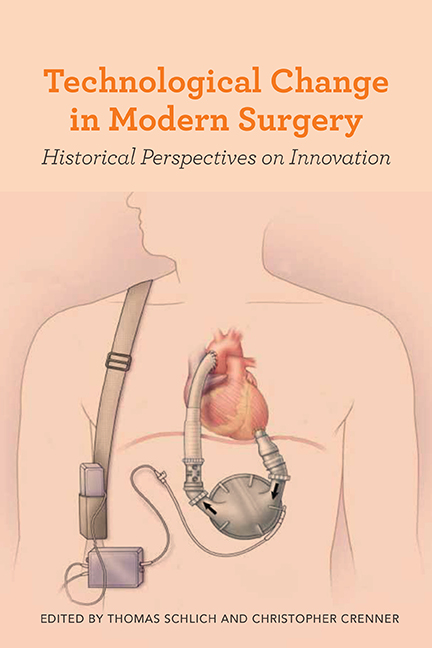Book contents
- Frontmatter
- Dedication
- Contents
- 1 Technological Change in Surgery: An Introductory Essay
- 2 Inimitable Innovation: Johann Friedrich Dieffenbach and the Renewal of Surgery, 1822–1847
- 3 Defining Difference: Competing Forms of Ovarian Surgery in the Nineteenth Century
- 4 “Making Bad Boys Good”: Brain Surgery and the Juvenile Court in Progressive Era America
- 5 Prosthetic Imaginaries: Spinal Surgery and Innovation from the Patient's Perspective
- 6 Disruptive Potential: The “Landmark” REMATCH Trial, Left Ventricular Assist Device (LVAD) Technology, and the Surgical Treatment of Heart Failure in the United States
- 7 Placebos and the Progress of Surgery
- 8 Surgical Practice and the Reconstruction of the Therapeutic Niche: The Case of Myocardial Revascularization
- Bibliography of Secondary Sources
- List of Contributors
- Index
5 - Prosthetic Imaginaries: Spinal Surgery and Innovation from the Patient's Perspective
Published online by Cambridge University Press: 09 June 2021
- Frontmatter
- Dedication
- Contents
- 1 Technological Change in Surgery: An Introductory Essay
- 2 Inimitable Innovation: Johann Friedrich Dieffenbach and the Renewal of Surgery, 1822–1847
- 3 Defining Difference: Competing Forms of Ovarian Surgery in the Nineteenth Century
- 4 “Making Bad Boys Good”: Brain Surgery and the Juvenile Court in Progressive Era America
- 5 Prosthetic Imaginaries: Spinal Surgery and Innovation from the Patient's Perspective
- 6 Disruptive Potential: The “Landmark” REMATCH Trial, Left Ventricular Assist Device (LVAD) Technology, and the Surgical Treatment of Heart Failure in the United States
- 7 Placebos and the Progress of Surgery
- 8 Surgical Practice and the Reconstruction of the Therapeutic Niche: The Case of Myocardial Revascularization
- Bibliography of Secondary Sources
- List of Contributors
- Index
Summary
In November 1960, Time magazine ran a splashy medical news report with the rather futuristic title “Spines of Steel.” The article featured the work of the orthopedic surgeon Paul H. Harrington (1911–80), who had devised a method of straightening scoliotic spines using a series of implantable metal rods and hooks embedded in the vertebral column. So as to visualize the sleekness of Harrington's instrumentation, Time included a black-and-white photograph of the physically imposing surgeon, his large hands gracefully clutching one of his metal rods, slender as a soda straw. Although Harrington did not have a definitive cure—or a method to prevent the occurrence of spinal curvatures caused by scoliosis—his rods promised a new era in scoliosis treatment, with traditional and seemingly more cumbersome modes of medical intervention left behind (figs. 5.1–5.2).
To many surgeons today, Harrington's innovation is seen as a pivotal moment in the surgical management of severe scoliosis. From the 1960s onward, Harrington's instrumentation would become the standard method of scoliosis correction and fusion throughout the world for more than a quarter of the century. In the words of two orthopedic surgeons writing in 1999, Harrington's “instrumentation was a clear milestone in scoliosis surgery providing for the first time, a reliable means of obtaining and maintaining maximal deformity correction.” The advantages of Harrington's system, they write, “were obvious.”
Whereas the success of Harrington's surgery may seem obvious to orthopedists practicing now, the advantage of metal implantation was not at all clear to his contemporaries. In the mid-twentieth century, leading practitioners in the field endorsed various forms of scoliosis treatment. According to a 1941 study of sixteen US orthopedic clinics in prominent university research centers, postural exercise was one of the most commonly prescribed modalities of treatment, even though many orthopedists doubted its efficacy. Other popular forms of treatment included body casts, bone fusions, or a combination of the two. Of the sixteen clinics surveyed, thirteen used the Risser turnbuckle cast, named after the inventor-orthopedist Joseph C. Risser (1892–1982).
- Type
- Chapter
- Information
- Technological Change in Modern SurgeryHistorical Perspectives on Innovation, pp. 100 - 128Publisher: Boydell & BrewerPrint publication year: 2017
- 1
- Cited by



